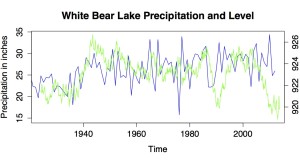Alright. We'll start with a basics of differential equations worksheet -- short and straightforward, and unbearably simple in the end. That's ok. One of the things I love about teaching DEs is that you can start so simply and get to such complex ideas in a pretty step-by-step manner. This worksheet is just a step one: a system of linear differential equations and some questions about equilibrium.
Even with this simple set-up there are so many questions that could be asked that I don't explore! What happens if the recruitment rate from transformation from hive bee to forager bee increases? What happens if the death rate of forager bees increases or decreases? How does laying rate affect equilibrium solutions? These are good questions for a classroom discussion to extend the worksheet.
Then the next step is to mercilessly criticize the models and make them better. There is a lot to criticize about these models: they're hopelessly simplistic, and students can figure that out by looking carefully at the bee life cycle information you provide them. Students love ripping apart these models and putting them back together better, and hopefully you can use those discussions to set an important tone:
Critiquing math models is a fun and respectful conversation that is not about who's talking, but about what is being said.
There is so much conversation in our modern world that involves criticizing something because of who said it, rather than looking at the idea itself. Just look at the top politics stories in the New York Times. Yes, we teach math, but we can also teach how to have constructive conversations about matters of fact and substance.
So! Here's the reading referenced in the worksheet:
The normal worker bee life-cycle is relatively well-understood, and basically goes as follows: the queen lays eggs which are tended by worker bees in the hive. These eggs develop into adults over about three weeks. Once the bees become adults, they work in the hive tending to new eggs or doing hive maintenance tasks (hive-cleaning and construction!). Survival rates in a healthy hive are very high, though not perfect. Once bees are old enough (18-21 days after emerging from their honeycomb) they become forager bees. The rate at which bees switch from hive living to foraging does depend on the ratio of forager bees to the size of the hive -- if there are not enough foragers, hive bees switch more quickly so that enough foragers can be bringing back pollen to feed the entire group. Forager bees are exposed to many more dangers and die at a much higher rate. There's also another mysterious mechanism that can happen if there are too many foragers and not enough hive bees: some forager bees can be convinced to come back and be hive bees.
(Information from Khoury-Myerscough-Barron, this site about bee life-cycle with pictures, and the honors thesis. Several of these reference Winston's book.)
Fun fact: all worker bees (and the queen) are female. Male bees are called drones. They mate with the queen but don't seem to do much useful work, and are all expelled from the hive in winter and die! Ok, maybe that part isn't fun...
Other fun links: Sherlock Holmes kept bees and (fictionally of course) wrote a book, "A Practical Handbook of Bee Culture, with some Observations upon the Segregation of the Queen." This love of bees is also important in Laurie King's Mary Russell series, in which Russell becomes Holmes' apprentice.
And if you don't need those basic bees... I'll soon put up a more sophisticated model!

